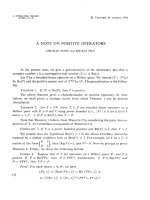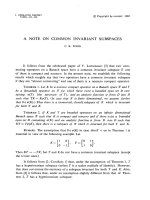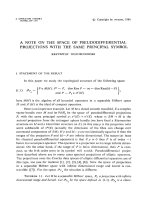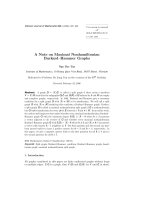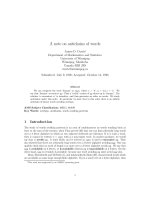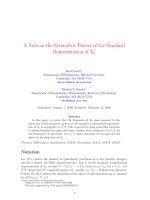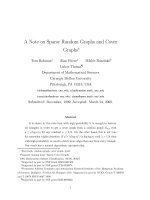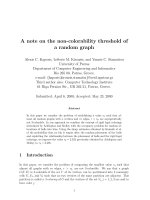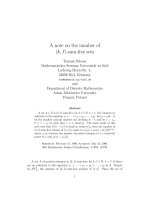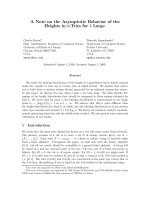Báo cáo toán học: "A note on packing graphs without cycles of length up to five" docx
Bạn đang xem bản rút gọn của tài liệu. Xem và tải ngay bản đầy đủ của tài liệu tại đây (66.68 KB, 3 trang )
A note on packing graphs without cycles
of length up to five
Agnieszka G¨orlich
∗
, Andrzej
˙
Zak
University of Science and Technology AGH, Al. Mickiewicza 30, 30-059 Krak´ow, Poland
{forys,zakandrz}@agh.edu.pl
Submitted: Feb 3, 2009; Accepted: Oct 20, 2009; P ublished: Oct 26, 2009
Mathematics Subject Classification: 05C70
Abstract
The follow ing statement was conjectured by Faudree, Rousseau, Schelp and
Schuster:
if a graph G is a non-star graph w ithout cycles of length m 4 then
G is a subgraph of its complement.
So far the best result concerning this conjecture is that every non-star graph G
without cycles of length m 6 is a subgraph of its complement. In this note we
show that m 6 can be replaced by m 5.
1 Introduction
We deal with finite, simple graphs without loops and multiple edges. We use standard
graph theory notation. Let G be a graph with the vertex set V (G) and the edge set
E(G). The order of G is denoted by |G| and the size is denoted by ||G||. We say that G is
packable in its complement (G is packable, in short) if there is a permutation σ on V (G )
such that if xy is an edge in G then σ(x)σ(y) is not an edge in G. Thus, G is packable
if and only if G is a subgraph of its complement. In [2] the authors stated the following
conjecture:
Conjecture 1 Every non-star graph G without cycles of length m 4 is packable.
In [2] they proved that the above conjecture holds if ||G||
6
5
|G| − 2. Wo´zniak proved
that a graph G without cycles of length m 7 is packable [6]. His result was improved
by Brandt [1] who showed that a graph G without cycles of length m 6 is packable.
Another, relatively short proof of Brandt’s result was given in [3]. In this note we prove
the following statement.
∗
The research was partially supported by a grant N201 1247/ 33
the electronic journal of combinatorics 16 (2009), #N30 1
Theorem 2 If a graph G is a non-star graph without cycles of length m 5 then G is
packable.
The basic ingredient for the proof of our theorem is the lemma presented below. This
lemma is both a modification and an extension of Lemma 2 in [4].
Lemma 3 Let G be a graph and k 1, l 1 be any positive integers. If there is a set
U = {v
1
, , v
k+l
} ⊂ V (G) of k + l independent vertices of G such that
1. k vertices of U have degree at most l and l vertices of U have degree at most k;
2. vertices of U have mutually disjoint sets of neighbors, i.e. N(v
i
) ∩ N(v
j
) = ∅ for
i = j;
3. G − U is packable
then there exists a packing σ of G such that U is an invariant set of σ, i.e. σ(U) = U.
Proof. Let G
′
:= G − U and σ
′
be a packing of G
′
. Below we show that we can find an
appropriate packing σ of G.
For any v ∈ V (G
′
) we define σ(v) := σ
′
(v). Then let us consider a bipartite graph B with
partition sets X := {v
1
, , v
k+l
}×{0} and Y := {v
1
, , v
k+l
}×{1}. For i, j ∈ {1, , k +l}
the vertices (v
i
, 0), (v
j
, 1) are joined by an edge in B if and only if σ
′
(N(v
i
)) ∩ N(v
j
) = ∅.
So, if (v
i
, 0), (v
j
, 1) are joined by an edge in B we can put σ(v
i
) = v
j
.
Without loss of generality we can assume that k l. Note that if deg v
i
l in G then
deg(v
i
, 0) k in B. Furthermore, if deg v
i
k in G then deg(v
i
, 0) l in B. Thus X
contains k vertices of degree k and l vertices of degree l. In the similar manner we
can see that Y contains k vertices of degree k and l vertices of degree l. In particular,
every vertex in Y has degree k. Let S ⊂ X. If |S| k then obviously |N(S)| |S|.
Suppose that k < |S| l. Then there is at least one vertex of degree l in S thus |N(S)|
l |S|. Finally, we show that if |S| > l, then N(S) = Y . Indeed, otherwise let (v
j
, 1) ∈ Y
be a vertex which has no neighbor in S. Thus deg(v
j
, 1) |X| − |S| < k + l − l = k,
a contradiction. Hence, for any S ⊂ X we get |S| |N(S)|. Therefore, by the famous
Hall’s theorem [5], there is a matching M in B. We define σ(v
i
) = v
j
for i, j ∈ {1, , k +l}
such that (v
i
, 0), (v
j
, 1) are incident with the same edge in M.
2 Proof of Theorem 2
Proof. Assume that G is a counterexample of Theorem 2 with minimal order. Without
loss of generality we may assume that G is connected. We choose an edge xy ∈ E(G)
with the maximal sum deg x + deg y of degrees of its endvertices among all edges of G.
Since G is not a star deg x 2 and deg y 2. Let U be the union of the sets of neighbors
of x and y different from x, y. Define k := deg x − 1, l := deg y − 1. We may assume that
k l. Consider graph G
′
:= G − {x, y}. Note that because of the choice of the edge xy,
U contains k vertices of degree l and l vertices of degree k in G
′
. Moreover, since G
the electronic journal of combinatorics 16 (2009), #N30 2
has no cycles of length 5, the vertices of U are independent in G
′
and have mutually
disjoint sets of neighbors in G
′
. By our assumption G
′
− U is packable or it is a star.
Assume that G
′
− U is packable. Thus, by Lemma 3, there is a packing σ
′
of G
′
such
that σ
′
(U) = U. This packing can be easily modified in order to obtain a packing of
G. Namely, note that there are vertices v, w ∈ U where v is a neighbor of x and w is
a neighbor of y such that σ
′
(v) is a neighbor of x and σ
′
(w) is a neighbor of y, or σ
′
(v)
is a neighbor of y and σ
′
(w) is a neighbor of x. In the former case (xσ
′
(v)yσ
′
(w))σ
′
is a
packing of G and in the latter case (xσ
′
(v))(yσ
′
(w))σ
′
is a packing of G. Thus we get a
contradiction.
Assume now that G
′
− U is a star (with at least one edge). Note that since G has no
cycles of lengths up to five, every vertex from U has degree 2 in G. Moreover, G has
a vertex which is at distance at least 3 from y. Let z denote a vertex which is not in U
and is at distance 2 from x, or if such a vertex does not exist let z be any vertex which
is at distance at least 3 from y. Furthermore, let W denote the set of neighbours of y.
Consider a graph G
′′
:= G − {y, z}. Thus W consists of l vertices of degree 1 in G
′′
and one vertex of degree k l in G
′′
. Note that G
′′
− W has an isolated vertex, namely
a neighbour of x. Thus G
′′
− W is not a star, hence it is packable. Moreover vertices
from W are independent and have mutually disjoint sets of neighbours in G
′′
. Thus by
Lemma 3 there is a packing σ
′′
of G
′′
such that σ
′′
(W ) = W . Then (yz)σ
′′
is a packing of
G. Therefore, we get a contradiction again, so the proof is completed.
References
[1] S. Brandt, Embedding graphs without short cycles in their complements, in: Y. Alavi,
A. Schwenk (Eds.), Graph Theory, Combinatorics, and Application of Graphs, 1 (1995)
115–121
[2] R. J. Faudree, C. C. Rousseau, R. H. Schelp, S. Schuster, Embedding graphs in their
complements, Czechoslovak Math. J. 31 (106) (1981) 53–62
[3] A. G¨orlich, M. Pil´sniak, M. Wo´zniak, I. A. Ziolo, A note on embedding graphs without
short cycles, Discrete Math. 286 (2004) 75–77.
[4] A. G¨orlich, M. Pil´sniak, M. Wo´zniak, I. A. Ziolo, Fixed-point-free embeddings of
digraphs with small size, Discrete Math. 307 (2007) 1332–1340.
[5] P. Hall, On representatives of subsets, J. London Math. Soc. 10 (1935) 26–30.
[6] M. Wo´zniak, A note on embedding graphs without short cycles, Colloq. Math. Soc.
Janos Bolyai 60 (1991) 727–732.
the electronic journal of combinatorics 16 (2009), #N30 3
